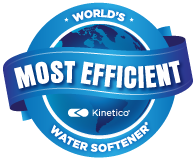Your Water May Have Iron
Iron is a chemical element with the symbol Fe and atomic number 26. It is a metal in the first transition series. It is by mass the most common element on Earth, forming much of Earth’s outer and inner core.
If there are iron stains on your sinks and bathtubs, if you use large amounts of soap to clean dishes, wash your hair or suffer the “orange hair” effect sometimes caused by iron water, you probably have water that can be successfully treated with an iron removal system. If left untreated, the minerals will cause yellow/brown stains on fixtures and clothing, clogged pipes and appliances, shortened service lives for dishwashers, washing machines and water heaters, all adding to the cost of maintaining appliances while increasing the amount of energy consumed in your home. Water softeners eliminate the effects of hard water; our system eliminates iron and objectionable effects. When it’s rust stains in your sinks and laundry, or an irony smell when you turn on a tap, your water problems can cause you and your family more than embarrassment and frustration. Iron can damage your fixtures and plumbing, discolor your laundry or create unpleasant odors in drinking water and showers.
Your Water May Have Iron
Iron is a chemical element with the symbol Fe and atomic number 26. It is a metal in the first transition series. It is by mass the most common element on Earth, forming much of Earth’s outer and inner core.
If there are iron stains on your sinks and bathtubs, if you use large amounts of soap to clean dishes, wash your hair or suffer the “orange hair” effect sometimes caused by iron water, you probably have water that can be successfully treated with an iron removal system. If left untreated, the minerals will cause yellow/brown stains on fixtures and clothing, clogged pipes and appliances, shortened service lives for dishwashers, washing machines and water heaters, all adding to the cost of maintaining appliances while increasing the amount of energy consumed in your home. Water softeners eliminate the effects of hard water; our system eliminates iron and objectionable effects. When it’s rust stains in your sinks and laundry, or an irony smell when you turn on a tap, your water problems can cause you and your family more than embarrassment and frustration. Iron can damage your fixtures and plumbing, discolor your laundry or create unpleasant odors in drinking water and showers.
Differences in Iron
There are hundreds of kinds of Iron. For water treatment they can be divided into three basic types, Ferrous, Ferric and Bacterial.
Ferris Iron
Dissolved iron. Water appears clear when drawn then may yellow after sitting. It also will stain porcelian fixtures and cause excessive cleaning. This iron can mostly be removed through the sodium ion-exchange of a water softener. However, in many situations an extra cleaner may be needed to be added to the regenerate.
Ferric Iron
Is an iron that changes from dissolved to a particulate upon oxidation. This iron will also cause staining on fixtures plus build up in appliance and plumbing. This iron must be physically trapped in a cartridge or media backwashing filter after oxidation.
Bacterial Iron
This is iron that tends to be a living organism and becomes very slimy. The bacteria isn’t necessarily dangerous but it creates a slime in your appliances and especially in your commodes water tank. Treatment of this iron is more specific using chlorination, ozonation or hydrogen peroxide with contact time and filtration to remove this iron.
Treatments
Chlorination, Air oxidation, Hydrogyn Peroxide, Pottassium Permanganate, Adsorbtion or a Water Softener. Some methods work better than others depending on the type and quanity of iron. If you have staining or iron taste in your water you should contact a dealer you trust and let them analyze your water to make recommendations for proper treatment.

